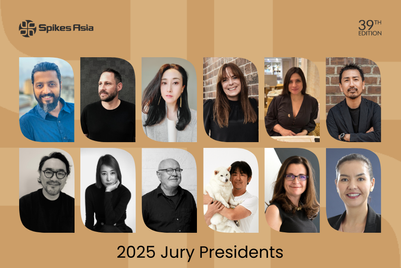
As witnessed at the Cannes Lions International Festival of Creativity in June, it has been a relatively subdued year for Asian creativity. Truly big ideas were less readily identifiable at this year’s Spikes Asia, and a number of markets underwhelmed. Nonetheless, there were patches of reassurance that the region has not yet lost its way, and indeed that suggest brands might simply be realigning their values.
Australia, Japan and New Zealand continued to dominate, claiming 126, 74 and 41 awards respectively. Both China and India’s hauls fell on last year, and Vietnam did not touch the scale, although on a more positive note, Indonesia won a Grand Prix — for the ‘Rural’ and ‘Urban’ print ads by Lowe for Unilever’s Pureit.

Marketing for good continues to move juries...
Grant Hunter, regional creative director at iris Worldwide, who judged the Innovation category, praised the ‘Life-saving dot’ as a piece of work that “taps into an existing behaviour and tackles an immense problem”. He described the other winner in the category, Hakuhodo Kettle’s ‘Eye play the piano’ for The University of Tsukuba, as “powerful” for opening up new possibilities for a disabled child through technology.
At the same time, fellow juror Johan Vakidis, ECD at R/GA, noted that technology is not everything when it comes to innovation, underscoring the simplicity of Grey’s winning work.
The entry that won the Creative Effectiveness Grand Prix, Lowe’s ‘Kan Khajura Station’ for Hindustan Unilever, also offered a simple solution to a major issue while encouraging people to spend real time with brands. Frequent power cuts in rural India often meant that the only device that works at home is the mobile phone. Unilever provided entertainment and brand messaging on demand. Jury president Nick Garrett, CEO of Colenso BBDO, called the work “a groundbreaking idea that proved beyond doubt the scale of the impact it had”.
In the same category, Ceylon Newspapers’ ‘Mosquito repellent newspaper’ by Leo Burnett in Sri Lanka stood out for building business by providing utility. But Garrett said overall, the quality of Creative Effectiveness entries had fallen on the previous year. “We are feeling the price of too much smaller and cause-related work winning of late and not enough big brand thinking that can demonstrate long-term success coming through,” he observed. “As an industry, this is a worry.”
The winners of the Digital and Mobile categories also sought to have a positive impact on society. In Digital, Colenso BBDO’s ‘Reduce Speed Dial’ for Volkswagen aimed to counter reckless driving with an app that enabled children to design the central element of their parents’ dashboards. “It’s a reflection of an emerging industry trend whereby digital is becoming more broadly defined,” said Arthur Policarpio, CEO of Mobext in the Philippines. “Digital is no longer just about the PC, the laptop, the tablet, the mobile phone. New realms of digital experiences are emerging that will unlock whole new computing platforms, with entirely new engagement opportunities for brands.”
Cheil’s ‘Look at me’ for Samsung, which claimed the Mobile and PR Grands Prix, drew praise for its level of ambition in tackling the sensitive subject of autism. On the negative side, Policarpio noted “a general lack of momentum when it comes to mobile work”. Digital entries outnumbered mobile two-to-one, he said, and overall quality was low. “The success of mobile in the startup world hasn’t quite translated yet into the advertising space.”
In PR, Weber Shandwick’s Pinto, presiding, said the ambition of the entries to aim to effect change was a positive thing, but that the widespread use of humour as a base was also a welcome development. She singled out ‘#My Family Can’ for SPC Ardmona by Leo Burnett Melbourne, and ‘Don’t Trade Me’ by DDB New Zealand for Paw Justice, as personal favourites for their social impact.
...but not everything has to be heavy to impress
In Film, Changyou dominated, with its irreverent ‘Mother’ spot (above) claiming the Grand Prix. The work aimed to overturn the perception of gaming as an antisocial waste of time in China by showing the perils of over-protective parenting.
Jury member Bobby Pawar, MD and chief creative director of Publicis Worldwide India, echoed concerns in other categories about a decline in the standard of entries, noting an absence in many cases of “interesting insights on the human condition”. Demonstrating insight is also not the same as being heavy. Changyou’s ‘Mother’, he said, really stood out for its intelligent but humorous approach. “It takes the accusations against gamers and turns the tables on the accusers ... It has the power to stimulate conversations.”
Other work that performed well in areas like Branded Content set out to entertain without claiming a link to any grander movement. Uni-president’s ‘Little House of Moments’ saw the creation of noodles based on people’s moods, and ultimately the opening of a physical noodle shop in response to positive consumer reaction on social media. And BBDO China’s ‘Endless Love Song’ for Master Kong—by coincidence another campaign for noodles—celebrated the ‘reunion of noodles and soup’ by personifying the two and casting them in a humorous historical series. Even the winning work designed to tackle serious issues, like drug driving and testicular cancer, used humour (and at times shock) to get their message across.
In Media, jury president Nick Waters, CEO of Dentsu Aegis Network Asia-Pacific, pointed to “a pivotal year” in terms of craft, saying it was “a delight to see the ability to use new technologies to create emotion and empathy with audiences. At the same time, the central idea of Grand Prix winner Tigerair’s ‘Infrequent Flyers Club’ by McCann Melbourne worked as a bit of apparent silliness that brought the brand’s personality to life.
Pawar indicated that he would like to see things continue to move away from “hawking good on behalf of brands”. “Do brands always need a nobler, bigger, existential purpose?” he asked. After all, “’The whitest teeth in the world’ may be enough of a purpose for a toothpaste brand, just as long as it keeps evolving the product to deliver on it.”



.jpg&h=268&w=401&q=100&v=20250320&c=1)





